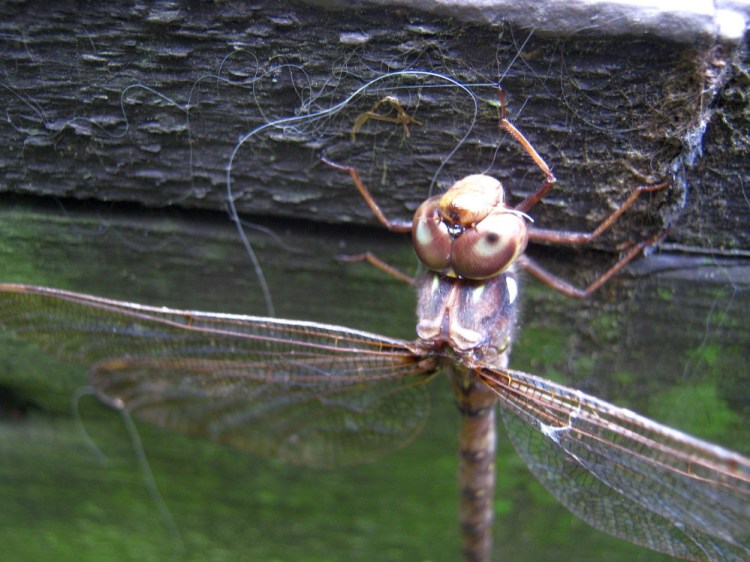This summer I’ve been getting phone messages, emails and notes at what seems like a stepped up rate asking me to explain why black flies, dragonflies, butterflies, maple trees, bats or something else are having a problem.
The answer to the question almost always is: I don’t know.
Since I’m only an amateur naturalist, I can’t explain anything scientific on my own authority. However, I’m still quite interested in the questions.
For example, dragonflies. They spend every summer buzzing around our yard combing mosquitoes and gnats out of the air in such large numbers you wonder if some mini-heliport isn’t set up nearby. But this summer there’s been a downright dearth of them here, and several people have written asking where their dragonflies have gone. Did the dragonfly population suffer some invisible blow this summer?
Or for another example, black fly season this May lasted only about five days here in the Troy woods. Usually we walk around waving our hands in front of our faces like Tom o’ Bedlam for about three weeks. And I received a couple of messages asking “Where have all the black flies gone?”
We had noticeably fewer white admiral butterflies this summer and last, and hardly a mourning cloak to be seen, whereas they used to be fluttering all up and down the driveway.
Now, when you put these observations together with other similar stray facts — such as, for example, some environmental groups recently petitioned the federal government to place monarch butterflies on the endangered species list — then your pseudo-scientific mind can really get onto a highway with no exit ramps.
My dragonflies are disappearing and my mosquitoes are increasing; my black fly numbers shrank (no harm, no foul on this one, maybe, I don’t know); the summer bat colony in the attic has been diminishing for several years; and like another reader, I have not seen a barn swallow in a long, long time.
Note to self: Several scientific studies (in which I did not participate) have concluded that life on Earth appears to be undergoing an alarming number of extinctions. One study found that at least 80 of 5,570 species of mammals have gone extinct in the past 500 years. If things keep going the way they are, the scientists say, 75 percent of all present animal species could be gone within 300 years. This phenomenon is referred to as the “sixth great extinction” because the fossil record indicates Earth has suffered mass losses of species like this five other times in the last 500 million years.
What causes these sudden obliterations of 50 to 90 percent of animal species is not known, though there are working theories. Large asteroid impacts, maybe, or massive volcanic eruptions spewing soot and smoke around the world. In our era, there’s a consensus that global warming — which is at least significantly enhanced, and probably outright caused by human activities — underlies the stepped-up rate of species loss.
Holy cow. Are my dragonflies going extinct?
Luckily, there are people whose job is to find out the answer to questions like this. The state’s biologists have devised three categories of species discovered by research to be suffering population declines: endangered (in most critical danger), threatened and special concern.
Only one species of dragonfly, the rapids clubtail, which I’m pretty sure I’ve never seen anyway, is on Maine’s endangered list. Two are on the threatened list: the boreal snaketail and the ringed boghaunter, which I’ve also never seen. On the species of special concern list, however, are 25 species of dragonflies and damselflies, a couple of which, like the big bluet, I think I have seen.
What about the black flies and bats? Little brown bats (who haunt our attic) and several others are on the special concern list, which I guess is due mainly to their decimation by white-nose syndrome. Two of them have been proposed for addition to the endangered list.
So are animals going extinct right in my backyard?
Charlene Donahue, president of the Maine Entomological Society and a state forest entomologist, told me no projects are formally monitoring dragonfly numbers, so even if she had heard of dragonfly dearths (which she had not) there would be no data to draw any conclusions from, anyway. “They have been patrolling pretty hard at my house,” she said, adding: “The nymphs live in the water so if there has been heavy rain and runoff from pesticide treated yards or fields into ponds, lakes and streams this could affect dragonfly populations.”
She said she’s heard people mention fewer black flies this year, and noticed it herself, but again, there are no data to draw any conclusions from.
“Some of it may be related to less flooding in the spring that translates into less habitat for black fly larvae to live in,” she said, “or it may be a function of warmer weather in Maine that has pushed black fly populations north. Or it may not be a reality, just a perception.”
Also, interestingly, while monarch butterflies are suffering a well-documented radical decline in North America, Donahue said a couple of people have told her they’ve seen more monarchs than usual this year in Maine.
So what’s going on?
In science, this is all about the careful analysis of hard physical evidence. There is evidence to show that about a couple of dozen species of dragonflies and damselflies in Maine are showing notable population declines. (As are barn swallows, by the way — they’re on the special concern list with more than 50 other bird species.) There is no evidence, however, to show that dragonflies suddenly started dying out in central Maine this year, even though there were noticeably fewer in my backyard.
In the humanities, we call this the problem of appearance and reality. It’s a condition of reality that all emotionally mature adults understand quite well: What appears to be happening is not necessarily what’s really happening.
The fact that fewer dragonflies appeared in my yard does not mean there are fewer dragonflies. The fact that it got cold at your house last January does not mean there’s no such thing as global warming.
How to find out what’s really happening? Stop believing your own guesses, and keep asking questions.
Dana Wilde lives in Troy. His writings on Maine’s natural world are collected in “The Other End of the Driveway,” available from online booksellers or by contacting the author at naturalist@dwildepress.net. Backyard Naturalist appears the second and fourth Thursdays each month.
Send questions/comments to the editors.




Comments are no longer available on this story